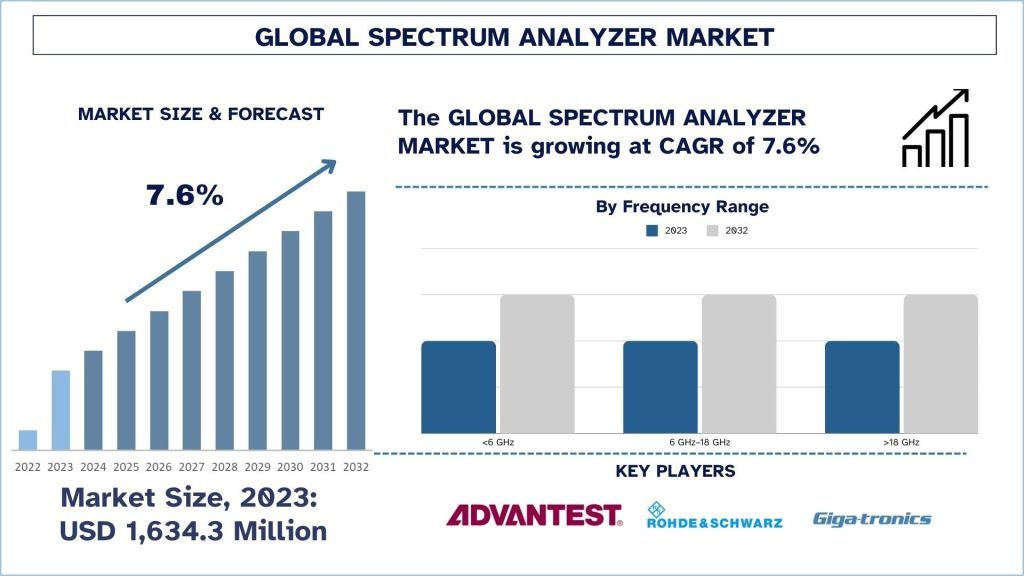Spectrum Analyzer Market: Current Analysis and Forecast (2024-2032)
Emphasis on Frequency Range (<6 GHz, 6 GHz–18 GHz, and >18 GHz); Form Factor (Handled, Portable, and Benchtop); Network Technology (Wired, and Wireless); Region/Country.
Spectrum Analyzer Size & Forecast
The Spectrum Analyzer market was valued at USD 1,634.3 Million in 2023 and is expected to grow at a robust CAGR of around 7.6% during the forecast period (2024-2032) owing to the increasing investment in 5G investment.
Spectrum Analyzer Analysis
A spectrum analyzer is an electronic device used to measure and display the amplitude of input signals across a frequency range, identifying and analyzing signal frequencies, bandwidths, and distortions. It plays a critical role in various applications, including telecommunications, electronics manufacturing, automotive, aerospace, and defense, where precise signal measurements are crucial. The market for spectrum analyzers is driven by the rapid expansion of wireless communication networks, increasing demand for portable and handheld devices, and the rising complexity of signal environments due to the proliferation of IoT devices. Additionally, the shift towards 5G technology, ongoing advancements in RF and microwave technologies, and the growing need for efficient spectrum management are major factors propelling the market forward.
The growth of the spectrum analyzer market has significant implications for business investment, technological advancements, and market dynamics. Companies are increasingly investing in R&D to develop advanced spectrum analyzers with higher accuracy, wider frequency ranges, and enhanced user interfaces to cater to the evolving needs of industries. Technological advancements, such as the integration of machine learning algorithms for automated signal analysis and the development of multi-functional analyzers, are also shaping the market. Moreover, there have been notable mergers and acquisitions, such as Aeroflex signing an asset purchase agreement to acquire the spectrum analyzer assets of LIG Nex1, indicating a trend toward market consolidation and expansion of product portfolios. Furthermore, large-scale orders from sectors like defense and telecommunications, driven by the need for robust signal monitoring and testing solutions, highlight the growing demand and competitive nature of the market.
Looking ahead, the spectrum analyzer market is expected to see substantial growth in regions such as Asia-Pacific, driven by the rapid industrialization and expansion of communication networks in countries like China, India, and Japan. These countries are investing heavily in 5G infrastructure, which necessitates advanced testing and monitoring equipment, including spectrum analyzers. Moreover, supportive government policies, such as the allocation of new frequency bands for communication and favorable regulations encouraging technological innovation, are expected to further stimulate market growth. The focus on smart cities, IoT, and Industry 4.0 initiatives in developed and developing nations alike will also boost the adoption of spectrum analyzers, making them indispensable tools for ensuring efficient and reliable communication networks in the future.
Spectrum Analyzer Trends
This section discusses the key market trends that are influencing the various segments of the Spectrum Analyzer as identified by our team of research experts.
Government Policies Supporting the Spectrum Analyzer Industry
- Spectrum Allocation and Management: Government policies focusing on spectrum allocation and management play a crucial role in the growth of the spectrum analyzer market by ensuring that frequency bands are used efficiently and effectively. These policies help prevent interference and optimize spectrum usage for various technologies, including 5G and IoT. For example, the FCC Spectrum Auctions in the United States are designed to auction off frequency bands to telecommunications companies for new technologies, including 5G networks. This process not only supports the expansion of 5G infrastructure but also drives demand for advanced spectrum analyzers that can manage and monitor these newly auctioned frequency bands, ensuring optimal performance and compliance.
- Telecommunications Infrastructure Investment: Significant government investment in telecommunications infrastructure drives the need for advanced spectrum analyzers by supporting the development and deployment of new communication technologies. Such investments help enhance network capacity, speed, and reliability. An example is the EU’s Connecting Europe Facility (CEF), which provides substantial funding to improve and expand high-speed broadband networks and 5G infrastructure across Europe. This funding accelerates the rollout of next-generation networks, increasing the demand for sophisticated spectrum analyzers that can ensure the efficient management and optimization of these advanced communication systems.
- Regulatory Standards for Wireless Communication: Regulatory standards established by governments for wireless communication help ensure that signal quality and spectrum efficiency are maintained, creating a demand for precise spectrum measurement tools. The ITU-R Recommendations issued by the International Telecommunication Union Radiocommunication Sector provide guidelines and regulations for managing radio frequencies and mitigating interference. These recommendations help standardize spectrum management practices globally, which necessitates the use of advanced spectrum analyzers to comply with these regulations, monitor signal quality, and ensure efficient spectrum utilization.
- Support for R&D and Innovation: Government policies that support research and development (R&D) in telecommunications and electronics contribute to the advancement of spectrum analyzer technology by providing funding and incentives for innovation. The Horizon Europe Program, for instance, is a major EU funding initiative that supports research and innovation projects across various technology sectors, including telecommunications. By funding projects focused on developing new spectrum analysis technologies and improving existing solutions, this program drives technological advancements in the spectrum analyzer market, supporting growth and innovation within the industry.
- Smart City Initiatives: Government-backed smart city initiatives that integrate IoT, advanced communication technologies, and data analytics increase the need for sophisticated spectrum monitoring solutions. The Smart Cities Challenge in the U.S., launched by the Department of Transportation, provides grants to cities developing innovative smart infrastructure and technology solutions. These projects often require advanced spectrum analyzers to monitor and manage the complex wireless communication networks involved, driving demand for high-performance spectrum analysis tools that can support the connectivity and efficiency of smart city systems.
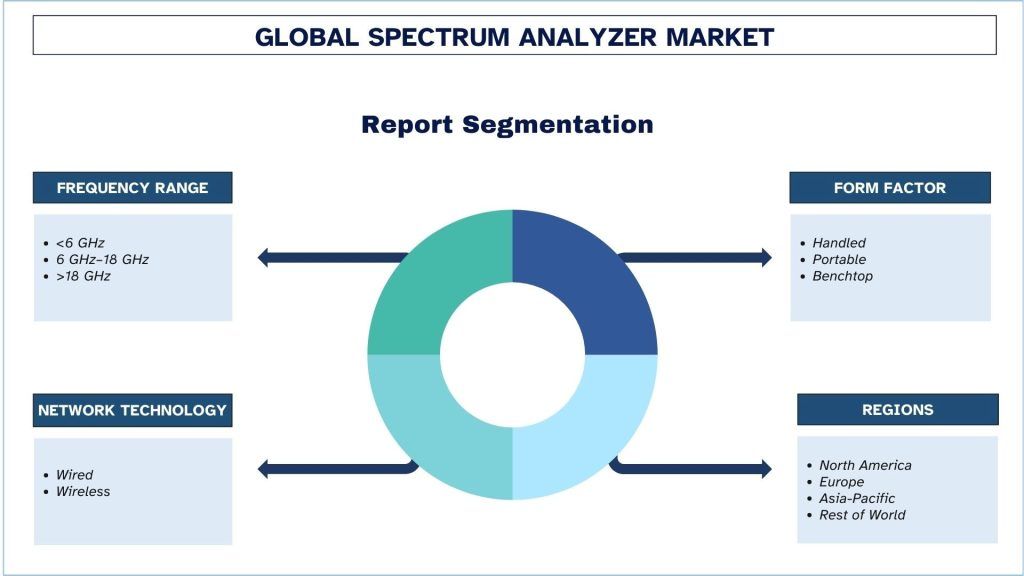
APAC is Expected to Grow with Significant CAGR During Forecast Period
The Asia-Pacific (APAC) region is a significant and rapidly growing market for spectrum analyzers, driven by the region’s robust expansion in telecommunications and electronics industries. Countries like China, India, and India are leading this growth due to their large-scale investments in 5G infrastructure and smart technologies. The rise in IoT applications and the increasing demand for high-speed wireless communication further fuel market growth. Additionally, APAC’s focus on technological advancements and manufacturing capabilities supports the adoption of advanced spectrum analysis tools. Government initiatives and favorable policies promoting technological innovation and digital transformation also contribute to the market’s expansion. The region’s diverse industrial base, including automotive, aerospace, and defense sectors, further drives the demand for sophisticated spectrum analyzers. Despite its potential, the market faces challenges such as varying regulatory standards and intense competition among key players. Overall, APAC presents significant opportunities for growth, supported by its dynamic technological landscape and increasing investment in communication infrastructure.
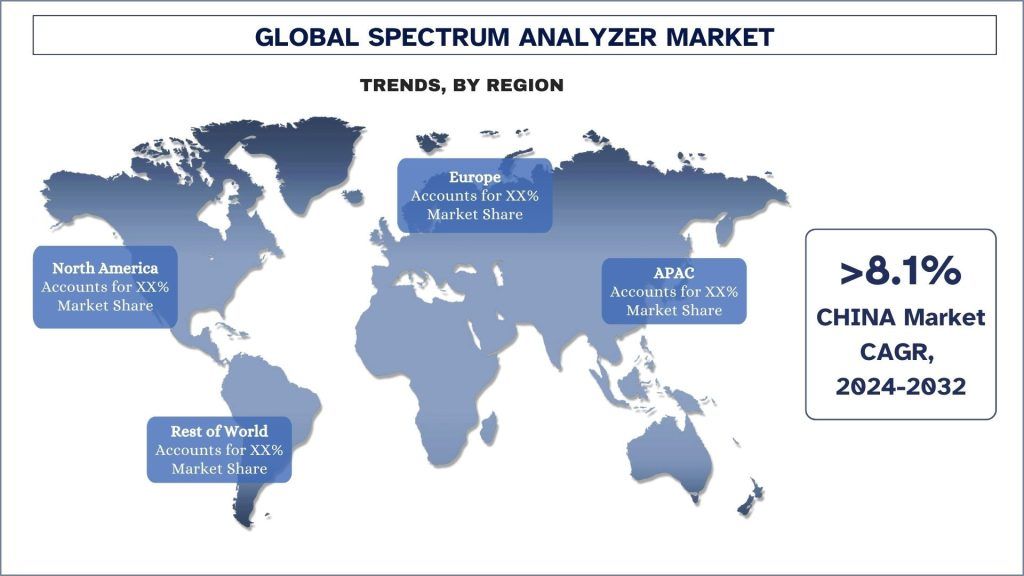
Spectrum Analyzer Industry Overview
The Spectrum Analyzer market is competitive and fragmented, with the presence of several global and international market players. The key players are adopting different growth strategies to enhance their market presence, such as partnerships, agreements, collaborations, new product launches, geographical expansions, and mergers and acquisitions. Some of the major players operating in the market are Advantest Corporation, Anritsu Corporation, B&K Precision Corporation, Giga-tronics Incorporated, Keysight Technologies, National Instruments Corporation, RIGOL Technologies Inc., Rohde & Schwarz GmbH & Co, SAF Tehnika, Tektronix U.K Limited.
Spectrum Analyzer Report Coverage
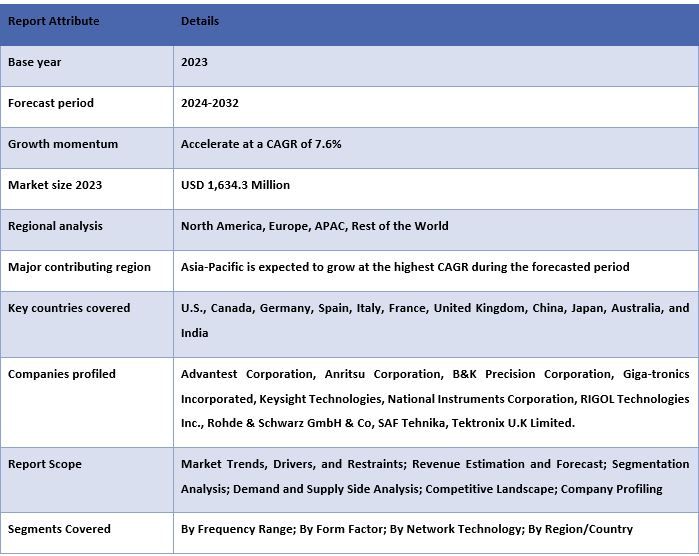
Reasons to buy this report:
- The study includes market sizing and forecasting analysis validated by authenticated key industry experts.
- The report presents a quick review of overall industry performance at one glance.
- The report covers an in-depth analysis of prominent industry peers with a primary focus on key business financials, product portfolios, expansion strategies, and recent developments.
- Detailed examination of drivers, restraints, key trends, and opportunities prevailing in the industry.
- The study comprehensively covers the market across different segments.
- Deep dive regional level analysis of the industry.
Customization Options:
The global Spectrum Analyzer can further be customized as per the requirement or any other market segment. Besides this, UMI understands that you may have your own business needs, hence feel free to contact us to get a report that completely suits your requirements.
Table of Contents
Research Methodology for the Spectrum Analyzer Analysis (2024-2032)
Analyzing the historical market, estimating the current market, and forecasting the future market of global Spectrum Analyzer were the three major steps undertaken to create and explore the adoption of Spectrum Analyzer in major regions globally. Exhaustive secondary research was conducted to collect the historical market numbers and estimate the current market size. Secondly, numerous findings and assumptions were taken into consideration to validate these insights. Moreover, exhaustive primary interviews were also conducted with industry experts across the value chain of the global Spectrum Analyzer Market. Post assumption and validation of market numbers through primary interviews, we employed a top-down/bottom-up approach to forecasting the complete market size. Thereafter, market breakdown and data triangulation methods were adopted to estimate and analyze the market size of segments and sub-segments of the industry. Detailed methodology is explained below:
Analysis of Historical Market Size
Step 1: In-Depth Study of Secondary Sources:
A detailed secondary study was conducted to obtain the historical market size of the Spectrum Analyzer through company internal sources such as annual reports & financial statements, performance presentations, press releases, etc., and external sources including journals, news & articles, government publications, competitor publications, sector reports, third-party database, and other credible publications.
Step 2: Market Segmentation:
After obtaining the historical market size of Spectrum Analyzer, we conducted a detailed secondary analysis to gather historical market insights and share for different segments and sub-segments for major regions. Major segments are included in the report such as Frequency Range, Form Factor, and Network Technology. Further country-level analyses were conducted to evaluate the overall adoption of testing models in that region.
Step 3: Factor Analysis:
After acquiring the historical market size of different segments and sub-segments, we conducted a detailed factor analysis to estimate the current market size of the Spectrum Analyzer. Further, we conducted factor analysis using dependent and independent variables such as Frequency Range, Form Factor, and Network Technology of the Spectrum Analyzer. A thorough analysis was conducted of demand and supply-side scenarios considering top partnerships, mergers and acquisitions, business expansion, and product launches in the Spectrum Analyzer sector across the globe.
Current Market Size Estimate & Forecast
Current Market Sizing: Based on actionable insights from the above 3 steps, we arrived at the current market size, key players in the global Spectrum Analyzer, and market shares of the segments. All the required percentage shares split, and market breakdowns were determined using the above-mentioned secondary approach and were verified through primary interviews.
Estimation & Forecasting: For market estimation and forecast, weights were assigned to different factors including drivers & trends, restraints, and opportunities available for the stakeholders. After analyzing these factors, relevant forecasting techniques i.e., the top-down/bottom-up approach were applied to arrive at the market forecast for 2032 for different segments and sub-segments across the major markets globally. The research methodology adopted to estimate the market size encompasses:
- The industry’s market size, in terms of revenue (USD) and the adoption rate of the Spectrum Analyzer across the major markets domestically
- All percentage shares, splits, and breakdowns of market segments and sub-segments
- Key players in the global Spectrum Analyzer in terms of products offered. Also, the growth strategies adopted by these players to compete in the fast-growing market
Market Size and Share Validation
Primary Research: In-depth interviews were conducted with the Key Opinion Leaders (KOLs) including Top Level Executives (CXO/VPs, Sales Head, Marketing Head, Operational Head, Regional Head, Country Head, etc.) across major regions. Primary research findings were then summarized, and statistical analysis was performed to prove the stated hypothesis. Inputs from primary research were consolidated with secondary findings, hence turning information into actionable insights.
Split of Primary Participants in Different Regions
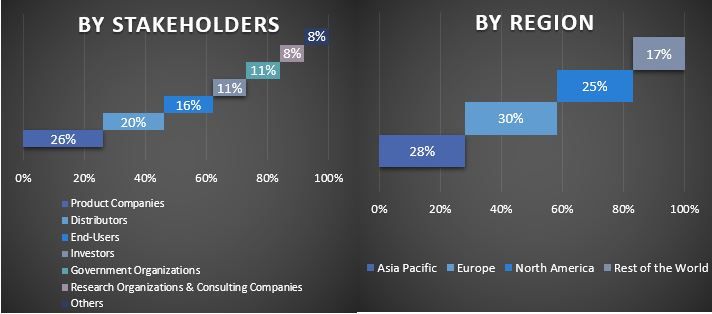
Market Engineering
The data triangulation technique was employed to complete the overall market estimation and to arrive at precise statistical numbers for each segment and sub-segment of the global Spectrum Analyzer. Data was split into several segments & sub-segments post studying various parameters and trends in the areas of Frequency Range, Form Factor, and Network Technology in the global Spectrum Analyzer Market.
The main objective of the Global Spectrum Analyzer Study
The current & future market trends of the global Spectrum Analyzer Market were pinpointed in the study. Investors can gain strategic insights to base their discretion for investments on the qualitative and quantitative analysis performed in the study. Current and future market trends determined the overall attractiveness of the market at a regional level, providing a platform for the industrial participant to exploit the untapped market to benefit from a first-mover advantage. Other quantitative goals of the studies include:
- Analyze the current and forecast market size of the Spectrum Analyzer in terms of value (USD). Also, analyze the current and forecast market size of different segments and sub-segments
- Segments in the study include areas of Frequency Range, Form Factor, and Network Technology
- Define and analysis of the regulatory framework for the Spectrum Analyzer industry
- Analyze the value chain involved with the presence of various intermediaries, along with analyzing customer and competitor behaviors of the industry
- Analyze the current and forecast market size of the Spectrum Analyzer for the major region
- Major countries of regions studied in the report include Asia Pacific, Europe, North America, and the Rest of the World
- Company profiles of the Spectrum Analyzer and the growth strategies adopted by the market players to sustain in the fast-growing market
- Deep dive regional level analysis of the industry
Frequently Asked Questions FAQs
Q1: What is the current market size and growth potential of the Spectrum Analyzer Market?
Q2: What are the driving factors for the growth of the Spectrum Analyzer market?
Q3: Which segment has the largest share in the Spectrum Analyzer market by Frequency Range?
Q4: What are the emerging technologies and trends in the Spectrum Analyzer market?
Q5: Which region will dominate in the Spectrum Analyzer market?
Related Reports
Customers who bought this item also bought

